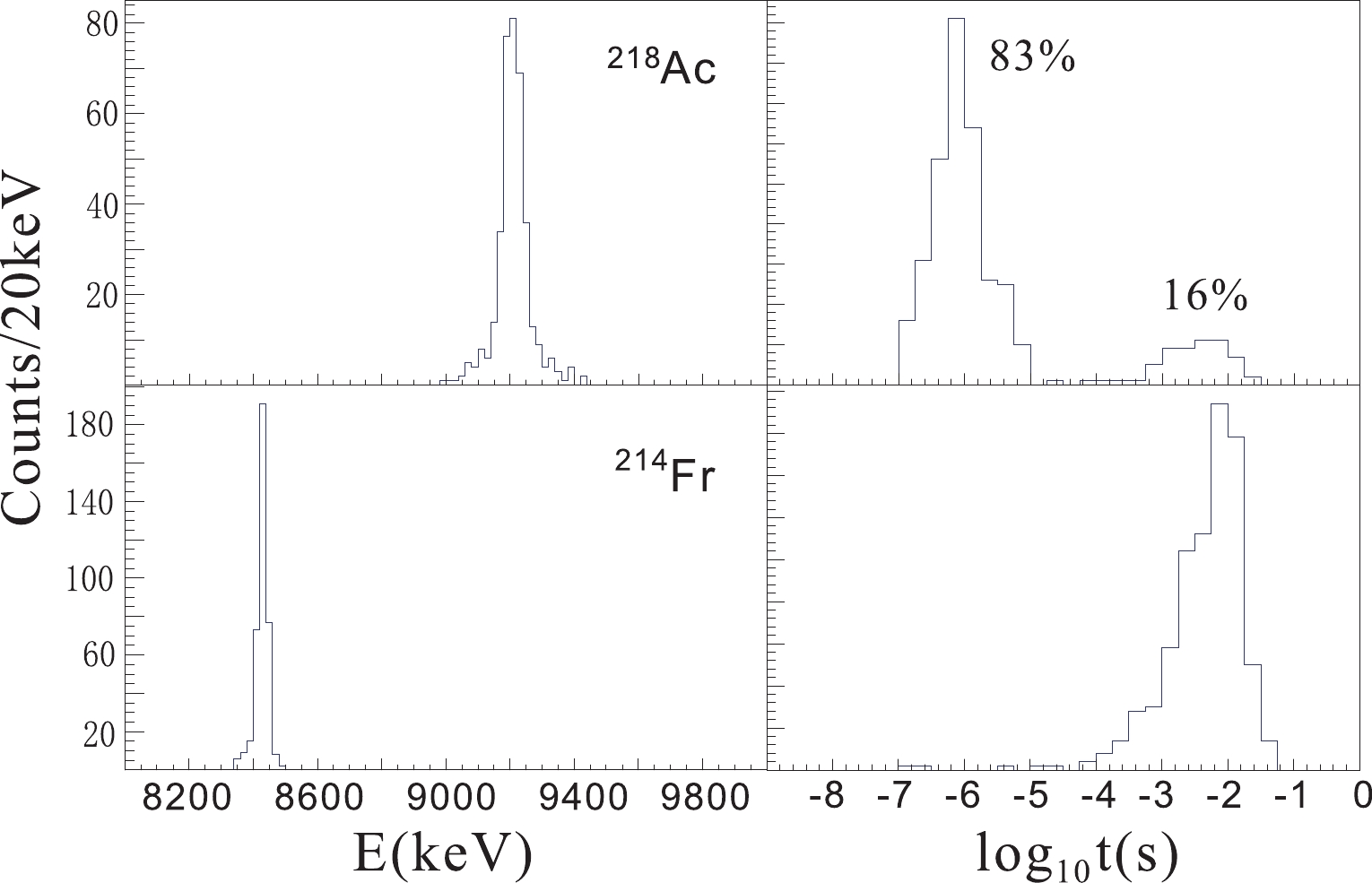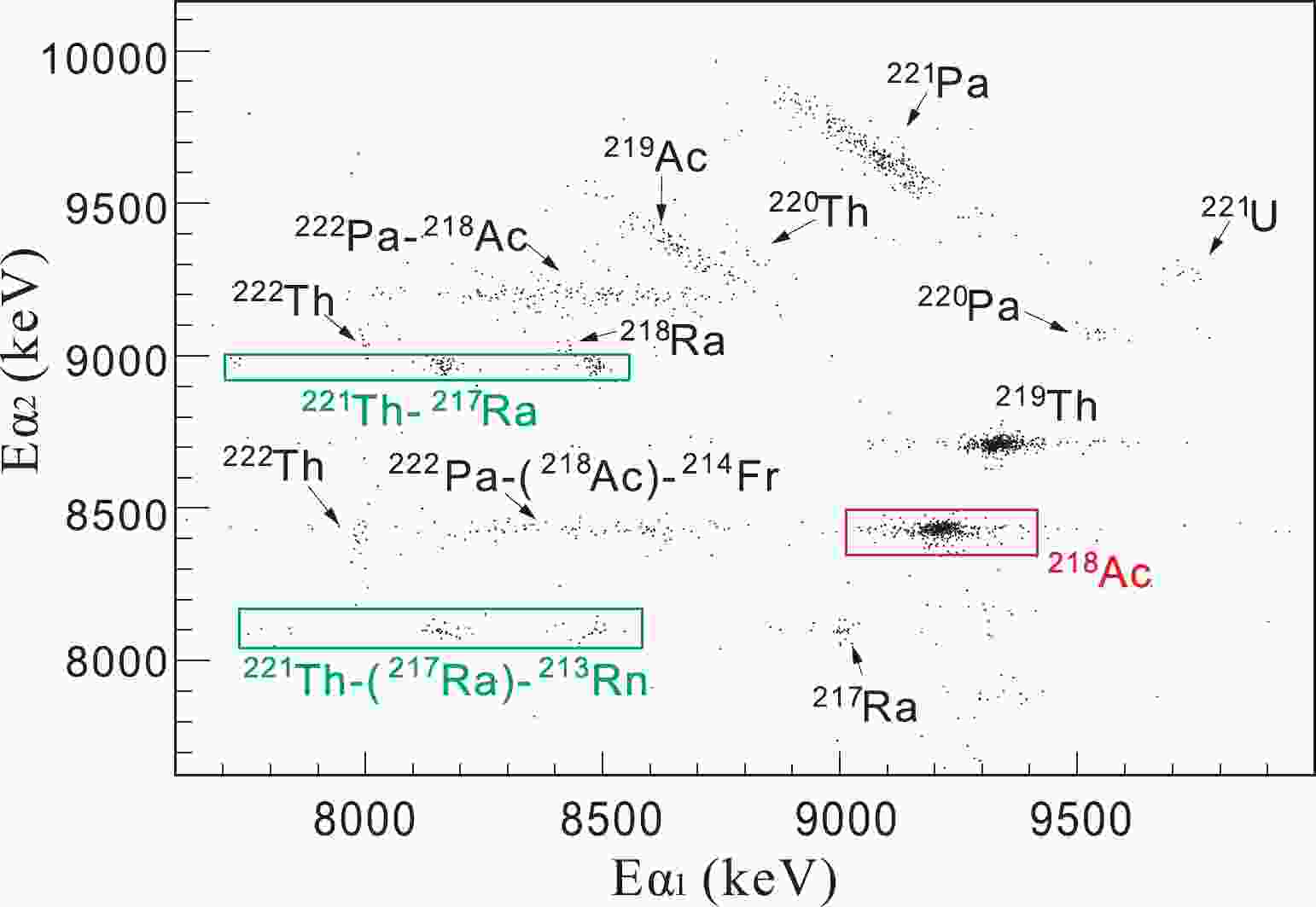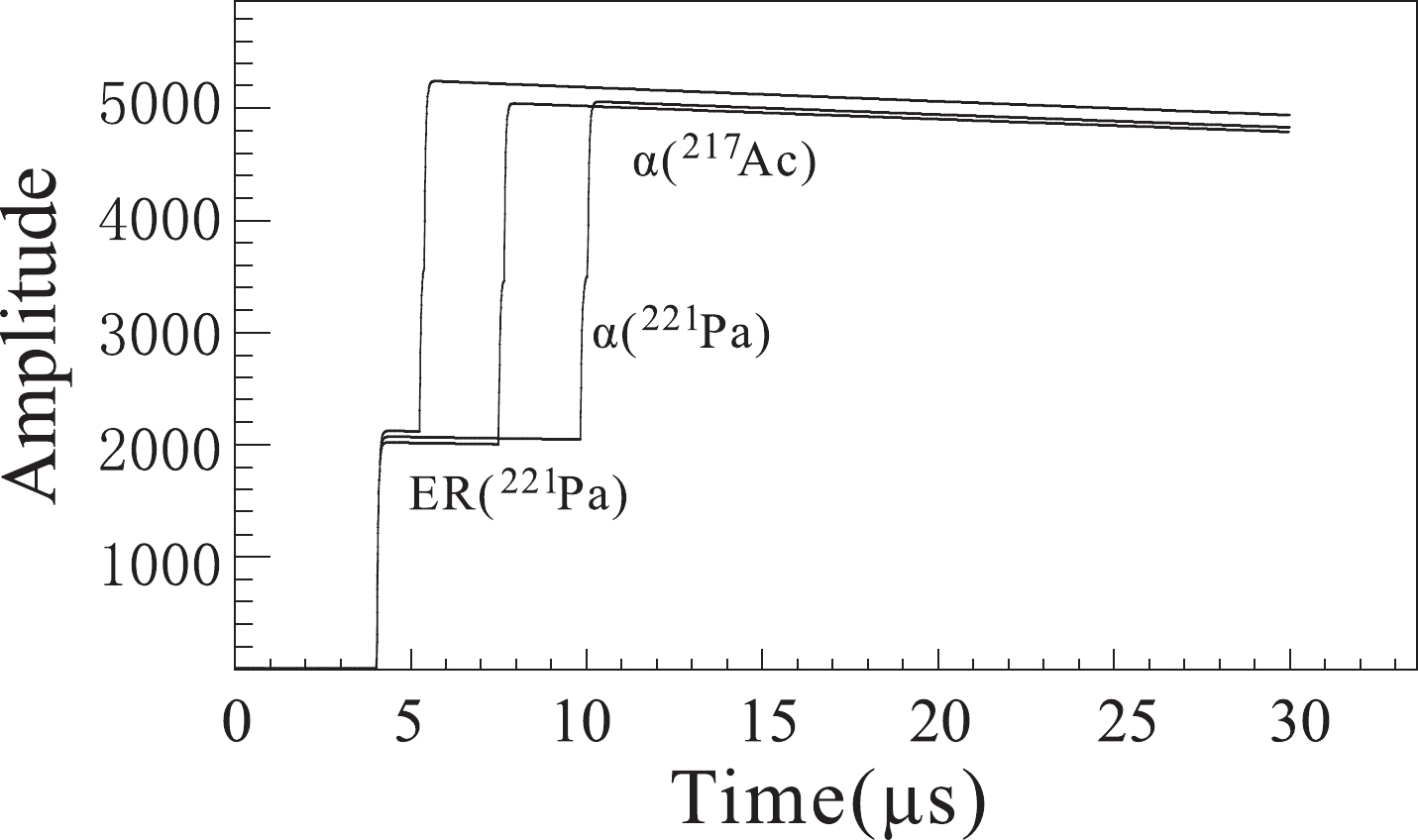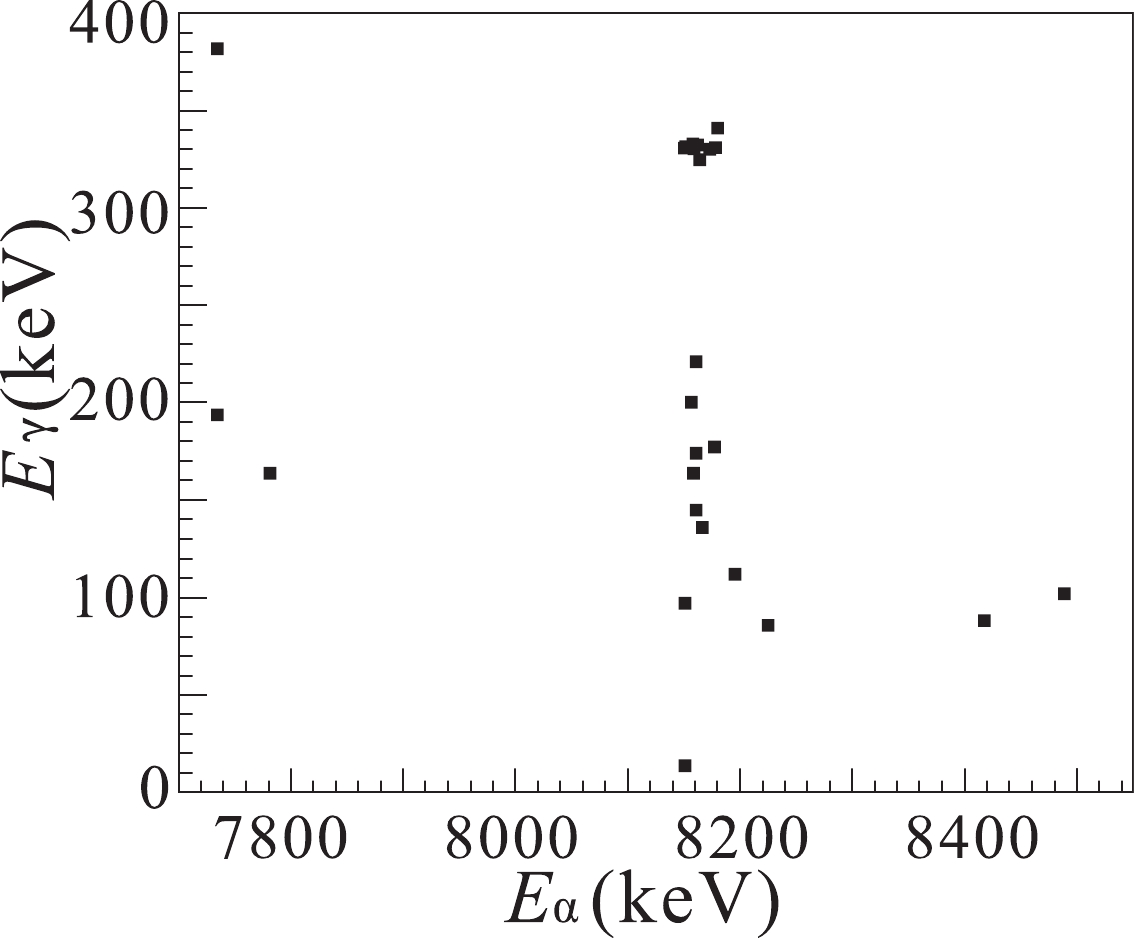-
At the neutron-deficient side of the nuclear chart, the α decay is one of the dominating decay modes for heavy nuclides. In recent years, by utilising a gas-filled separator, many new nuclides in the A≈200 region close to the proton drip line were newly synthesized successfully via heavy-ion induced fusion-evaporation reactions [1-9]. The known α-decay characteristics of such nuclides and their descendants help to study the new properties in the decay chains. Among the evaporating channels, we cannot distinguish the 2p2n and 1α channels, which have the same evaporated residues (ERs). It is also known that, owing to the different decay energies, there might be differences between these two decay manners. Cross section is one of the probes in practice. In this mass region, a fine structure of the ground-state α decay is expected to be observed. However, owing to their low cross section, short survival time, and old technology, many of them have not been confirmed yet. In recent years, owing to the excellent separation performance of the gas-filled spectroscopy, fast data acquisition, and upgraded detector arrays, the uncleared α-decay fine structures could be elucidated.
In this paper, we will discuss the experimental results of 218Ac and 221Th in Section III. The details of the conducted experiments are presented in Section II.
-
The experiments were performed at the Spectrometer for Heavy Atoms and Nuclear Structure (SHANS) [10] in Institute of Modern Physics (IMP), Lanzhou, China. A beam of 40Ar with an energy of 198.7 MeV and an intensitiy of 300
${\rm pnA}$ was provided by the Sector-Focusing Cyclotron (SFC) of the Heavy Ion Research Facility in Lanzhou (HIRFL). The 186W target with average thickness of 200$\rm \mu g/cm^2$ was evaporated on a 50$\rm \mu g/cm^2$ of carbon, and covered with a 10$\rm \mu g/cm^2$ of carbon layer. The evaporated residues (ERs) yielded in the fusion-evaporation reaction 40Ar + 186W were filtrated by the separator SHANS and implanted into three 300-$\mu\rm m$ -thick position-sensitive strip detectors (PSSDs) with each active area of 50×50$\rm mm^2$ . The front surface of each PSSD was divided into 16 strips along the perpendicular direction, leading to a horizontal position resolution of 3 mm. Eight additional non-position-sensitive side silicon detectors (SSDs) were mounted upstream, thereby forming a box geometry together with PSSDs. The total detection efficiency for the emitted α was measured to be ~72%. To distinguish the α events from the implanting events, two multi-wire proportional counters (MWPCs) were mounted 15 cm and 25 cm upstream from the PSSDs. Three extra non-position-sensitive silicon detectors, featuring the same size as the PSSDs, were installed side by side after the PSSDs to provide the veto signals from the light particles passing through the PSSDs. Near the charged particle detection system, two High Purity Germanium (HPGe) detectors and one clover detector were mounted at the right side, downward, and downstream, respectively. Signals from the preamplifiers of the Si-box, MWPCs, and veto detectors were recorded directly by a digital data acquisition system comprising sixteen V1724 waveform digitizers from CAEN S.p.A [11]. Every event was recorded in 30$\rm \mu s$ -long trace at a sampling rate of 100 MHz. More details of the system could be found in Refs. [2,3,12].Charged-particle energy calibration was performed using the 175Lu target with the same beam. With the help of an alcohol circulation cooling system, the energy resolution for unpileup trace was approximately 40 keV (FWHM) for 6.5-10 MeV α particles, and the vertical position resolution was approximately 1.5 mm (FWHM). For pileup signals with$\bigtriangleup T > 1 \rm \mu s$ , the typical energy resolution is 47 keV. However, for$\bigtriangleup T > 1 \rm \mu s$ = 0.5-1$\rm \mu s$ , the resolution worsens, becoming 70 keV. When the time difference is less than 100 ns, the extracted α energy from the pileup trace becomes unreliable.When ERs trigger the PSSDs, the emitted α is called
$ \alpha_{1} $ . The ERs named as the mother nuclide decayed to the excited or ground states of the daughter nuclide, which might deexcite by α decay again, denoted as$ \alpha_{2} $ . The same rule is applied to name$ \alpha_{3} $ for the α decay from the granddaughter nuclide following$ \alpha_{2} $ . The aforementioned signals occurred at the same position in the PSSDs. -
In the conducted experiment, some U, Pa, Th, and Ac isotopes were clearly identified, including 221U, 220-222Pa, 219-222Th, 218,219Ac, and 217,218Ra. The 2D plotting of the correlated events is presented in Fig. 1; the time windows were 30 ms for ER-
$ \alpha_{1} $ pairs and 50 ms for$ \alpha_{1}- \alpha_{2} $ pairs. -
When the time interval of
$ \alpha_{1} $ and$ \alpha_{2} $ is in the order of a few hundred nanoseconds, the pluse piles upon the next one. Consequently, the two extracted energies will not be accurate anymore, but the sum energy value continues to be reliable; this was the case of 221Pa, 219Ac, and 220Th clusters. Three waveforms of 221Pa events are shown in Fig. 2 as examples. For this type of pairs, they distribute on an oblique line in the 2D plotting, such that the intercept is the sum of two energies. Similarly, the$ E_{\alpha 1} $ energy peak projected from the 218Ac events is broader than that of$ E_{\alpha 2} $ from the 222Pa ones. That is due to the short half-life of 218Ac, whose energy could not be obtained accurately in the waveform.Each cluster of events was checked carefully. Two components are observed in the time distribution of the 218Ac events, shown in Fig. 3. The projected spectrum of these events displays a single-energy peak at 9205 keV, consistent with the previous measured values [13-15]. Thus, all of them are decaying from the ground state of 218Ac. The isomer decay manner is not the right one, which could be excluded logically. The less-yields component (16%) is attributed to the indirect process, originated from the α decay of 222Pa, whose emitted α particles failed to be detected. By solving the nonlinear nonhomogeneous first order differential equation with the approximation
$ \lambda _2 \gg \lambda _1 $ , the counts of 218Ac$ N(t) $ in the indirect process could be obtained.
Figure 3. (color online) The energy and time distribution of the events in the 218Ac cluster, with 218Ac in the upper part and 214Fr in the lower part.
$ \dfrac{{\rm d}N(t)}{{\rm d}t} = \lambda _1 N_0 e^{-\lambda _1 t}-\lambda _2 N(t) e^{-\lambda _2 t} . $

(1) Here,
$ N_0 $ denotes the counts of 222Pa that will decay to 218Ac later. For each event, the ER trigger time was set to zero, so$ N_0 $ is independent of time;$ \lambda_1 $ and$ \lambda_2 $ are the decay constants of 222Pa and 218Ac, respectively.Then, the second term shows the count ratio of α particles emitted from the ground state of 218Ac, whose function corresponds to the time distribution curve. The maximum locates at
$ t = \dfrac{1}{\lambda_1} $ , 10−2.33 here, whose value should correspond to the half life of 222Pa. Directed by a 95.5% confidence level, a half-life of$ 3.24^{+1.13}_{-0.66} $ ms was obtained. This is consistent with the value$ 2.76{^{+0.43}_{-0.33}} $ ms deduced from the 222Pa events(222Pa-218Ac and 222Pa-(218Ac)-214Fr) in this study. The half-life of the another 83% component was derived to be$0.78^{+0.10}_{-0.08} \mu\rm s$ . They are the evaporation residues from the compound nuclide 226U, i.e., the so called direct products. Thus, it refers to the ground state half-life of 218Ac measured in this experiment.When calculating the cross section of 1p3n channel (222Pa) in this reaction, we should take into account the contribution from the indirect process, along with the direct one of the 222Pa-218Ac and the 222Pa-(218Ac)-214Fr events. Simultaneously, the indirect part should be removed when counting the direct products 218Ac. Given that the missing ratio when detecting the decaying α from 222Pa and 218Ac and their transporting efficiency provided by SHANS are almost same, the direct process ratio of
$\dfrac{\sigma(^{226}{\rm U}^* \rightarrow1p3n+^{222}{\rm Pa})}{\sigma(^{226}{\rm U}^*\rightarrow3p5n+^{218}{\rm Ac})}$ deduced in this study is 0.69(9). The theoretical result computed by the Hivap2 code [16] with the commonly used parameters is 0.93. Further theoretical study by adjusting the fission barrier and the preformation factor is needed to analyze the experimental results. -
The refine α-decay structure of 221Th was investigated in many previous experiments [9,17-20]. However, only the branches with large ratios and the one that separates from the others clearly in energy scale were confirmed. In our measurements, besides the known α decays at 7731, 8164, and 8481 keV, two more small peaks were observed (shown in Fig. 4). The measured results in the present study and those in previous ones are compiled together in Table 1. For the sake of more accurate results, the listed energies and the half-lives of 217Ra and 213Rn were extracted from the 221Th-217Ra and 221Th-(217Ra)-213Rn clusters, respectively, to achieve higher statistics. The ground state to ground state
$ Q_\alpha $ was deduced to be 8672(10) keV when corrected for the recoil energy and the screening effect of the atomic electrons. In Fig. 4, the α spectrum of 221Th was obtained from the sum of 221Th-217Ra and 221Th-(217Ra)-213Rn events. Meanwhile, the spectra of 217Ra and 213Rn were only extracted from the 221Th-217Ra cluster to clarify the correlation information. The statistical countings shown in the figure are 89 and 52 for 217Ra and 213Rn, respectively. Two peaks at 8409 and 8249 keV, highlighted in red, are the ones that were mentioned once as a short note in Ref. [17] without spectra shown. In this measurement, there were four 4-fold coincidence chains founded for these two branches, listed in Table 2. Chains 1-3 were the ones at 8409 keV, whereas chain 4 was located at 8249 keV. These multi-correlations help to partially (not sufficiently) support their existence in the fine decay structure. To demonstrate the existence of the two controversial branches, the$ \gamma $ spectrum correlated with the decaying α particles of the mother nuclei is presented as an additional argument (Fig. 5).
Figure 4. (color online) Energy (left) and time distribution (right) of the events relative to the 221Th decay chains. The previous indeterminate α branches are labeled in red.
Isotope Eα/keV Intensity(%) $T_{1/2}^* $ 

Previous studies, Eα (Int.) Previous studies, T1/2 7731(17) 3.5 7730(10) keV(6%)[17], 7733(8) keV(6.0%)[18],
7.73(1) MeV(8(3)%)[19], 7732(15) keV(4(3)%)[9]221Th 8164(15) 52.5 8150(10) keV(53%)[17], 8146(5) keV(62.4%)[18],
8.145(10) MeV(62(5)%)[19], 8135(10) keV(48(9)%)[9],
8.11(4) MeV[20]1.68(6) ms[18], 1.8(3) ms[19], $ {2.0^{+0.3}_{-0.2}}$ ms[9], 1.0(2) ms[20]

8249(19) 2.1 $1.95{^{+0.38}_{-0.27}}$ ms

8265(10)(4%)[17], 8.23(4) MeV[20] 8409(16)# 6.4# 8375(10) keV(11%)[17] 8481(15) 35.5 8470 keV(10%)[17], 8472(5) keV(31.6%)[18],
8.470(10) MeV(30(5)%)[19], 8458(10) keV(48(9)%)[9]217Ra 8966(15) 100 $1.52{^{+0.42}_{-0.27} } \mu\rm s$ 

8990(8) keV[18], 8.995(10) MeV[19], 8.99(4) MeV[20] 4(2) $\mu\rm s$ [9], 1.6(2)

$\mu\rm s$ [19], 2.5(2)

$\mu\rm s$ [20]

213Rn 8100(15) $ 15.88{^{+5.47}_{-3.24}} $ ms

8.085(10) MeV(99%)[19], 7.55(15) MeV(15)(1%)[19],
8.09(1) MeV[20], 7.98(1) MeV[20]25.0(2) ms[19], 16(1) ms[20] (*) 95.5% confidence level is used to compute the half-life error; (#) tentative assignment. Table 1. Measured results in this study compared with values previously reported in the literature.
Chain No. EER/keV ${E}_{\alpha_1}$ /keV

$\Delta {\rm{t}}_{\alpha_1}$ /ms

${E}_{ \alpha_2}$ /keV

$\Delta {\rm{t}}_{ \alpha_2}$ /

$\mu{\rm{s} }$ 

${E}_{\alpha_3}$ /keV

$\Delta {\rm{t}}_{ \alpha_3}$ /ms

1 14059 8400 0.46 8958 3.00 8097 22.7 2 12498 8408 3.37 8968 3.18 8092 1.53 3 13462 8447 0.74 8971 1.98 8102 38.4 4 13100 8241 0.50 8953 0.68 8099 0.48 Table 2. Measured
$\alpha $ -decay chains ER-$ \alpha_1 - \alpha_2 - \alpha_3 $ for the two dubious components.$E_{\rm ER}$ ,$E_{\alpha 1}$ ,$E_{\alpha 2}$ , and$E_{\alpha 3}$ are the energies of the evaporation residue, mother nuclide, daughter nuclide, and granddaughter nuclide, respectively;$\Delta t$ is the decay time of the chain members.Only the
$ \gamma $ peak at 331 keV could be recognized in the spectrum; it coincides with the emitted α at 8164 keV. This is consistent with previous$ \gamma $ information [21], i.e.,$ \gamma $ decay from the excited state (323 keV, 11/2+) to the ground state 9/2+. The kinetic energy of the internal-conversion electrons from 331 keV$ \gamma $ will overlap on the 8164 keV α. With the known binding energy of electrons at K shell, i.e., 104 keV, an additional 227 keV energy will contribute to the counts at 8391 keV. Therefore, the small peak at 8409 keV may stem from the internal conversion effect. However, we cannot exclude the possible small branch decay to the level of 73 keV. This item is labeled with corner mark # in Table 1 as a tentative result. Through the Band-Raman method, the internal conversion ratios were calculated to be 0.4 and 0.06 for M1 and E2$ \gamma $ transitions, respectively. The upper-limit ratio deduced from this experiment was 0.12. Thus, this$ \gamma $ transition is mostly E2 type mixed with less M1. For the counts at 8249 keV, no other situations will generate them, except for a new decay branch. We list this item without the corner mark #.The reduced α-decay width
$ \delta^2 $ [22] could be deduced from the experimental information, including decay energy, half-life, relative intensity, and angular momentum$ l $ taken away by the emitted α particles. In the case of odd-mass nuclide decay chain, the$ l $ value is related to the valence nucleus configuration of the parent and daughter nuclides. The hindrance factor (HF) of the odd-mass nuclide is the factor normalized to$ \delta^2_{ee} $ (the ground state transition of the neighboring even-even nuclide). It could help us to elucidate the centrifugal barrier effect and discuss the configuration assignments.It is well known that even-even nuclides are unhindered in general. The value of 222Th is
$ 134^{+109}_{-41} $ , according to this experiment. We used this value as$ \delta^2_{ee} $ to calculate the hindrance factors of 221Th, for which the$ \Omega $ = 1/2,$ i_{11/2} $ neutron orbital dominates the ground state$ 7/2^+ $ [23]. The α-decay widths calculated from the present data are tabulated in Table 3;$ l $ was set to be 0, 2, and 2 for branches 1, 2, and 5, respectively, according to the previous spin-parity assignments [3] and the conservation law of parity and angular momentum. By employing the data listed in Table 1 and the aforementioned$ l $ , the g.s to g.s decay shows an HF of 44, while decays from g.s to the excited states at 764(23) and 323(20) keV are much less retarded with HF 3. The nuclei investigated here are expected to be dominated by the shell model orbital$ g_{9/2} $ , while$ i_{11/2} $ and$ j_{15/2} $ also have certain contributions. In shell model calculation, the states dominated by$ \nu j_{15/2} $ lie higher than others. Thus, the possibility of$ \nu j_{15/2} $ is excluded at the first step. In the in-beam$ \gamma $ spectra study of 217Ra [24], the ground state was assigned to$ 9/2^+ $ with the configuration of$ \nu g^3_{9/2} $ (seniority number = 1). Concerning the ground state of 221Th, the odd neutron is regarded to mainly occupy the$ i_{11/2} $ orbital at moderate axial quadrupole-octupole deformation [25]. These terms strongly hinder the α decay from the ground state$ 7/2^+ $ (221Th) to the ground state$ 9/2^+ $ (217Ra). Both$ \nu g^3_{9/2} $ and$ \nu g^2_{9/2} i_{11/2} $ could give rise to the$ 11/2^+ $ state at 323 keV, but its small HF value proposes its final valence neutron occupation to be the same as that of the ground state of 221Th, that is,$ \nu i_{11/2} $ . Regarding the level at 764 keV, the HF value is as small as that of the$ 11/2^+ $ state, no matter taking either l=0 or 2. Consequently, it has the same configuration,$ \nu g^2_{9/2} i_{11/2} $ , and keeps the earlier assignment$7/2 ^+ $ . Similar to the$ 9/2^+ $ state, the levels at 73 and 236 keV (identified from 8249- and 8409-keV α) have larger HF values increased by two orders of magnitude, regardless of the value of$ l $ assigned. Thus, the configuration$ \nu g^3_{9/2} $ is expected for those two states tentatively. Further$ \gamma $ spectra studies on these levels are required to specify the$ J^\pi $ assignments.No. $E_{\alpha}$ /keV

$E_{x}$ /keV

$J^{\pi}$ 

$l$ 

$\delta^2 /{\rm keV}$ 

HF 1 7731(17) 764(32) $7/2^+$ [18]

0 $40^{+8}_{-6}$ 

$3.4^{+2.1}_{-0.5}$ 

2 8164(15) 323(30) $11/2^+$ [24]

2 $46^{+9}_{-6}$ 

$2.9^{+1.8}_{-0.5}$ 

3 8249(19) 236(34) 2 $1.0^{+0.2}_{-0.1}$ 

$134^{+82}_{-28}$ 

4 8409(16)# 73(31)# 2 $1.1^{+0.2}_{-0.2}$ 

$134^{+85}_{-17}$ 

5 8481(15) 0 9/2+ [24] 2 $4^{+1}_{-1}$ 

$44^{+25}_{-3}$ 

Table 3. Reduced decay width and hindrance factor of 221Th inferred from the experimental data.
$E_x$ and$J^\pi$ are the energy and spin-parity of states in 217Ra, respectively. -
In this study, several U, Pa, Th, and Ac isotopes (221U, 222-220Pa, 219-222Th, 218,219Ac, 217,218Ra) were produced via the fusion-evaporation reaction 40Ar (
$^{186}{\rm W}$ , xpxn) in the Institute of Modern Physics, Chinese Academy of Sciences. They were separated by SHANS and identified by the charged-particle and$ \gamma $ detector array at the terminal. Some products of 218Ac came from the direct process (ERs of the compound nuclide 226U), specifically those left from the indirect process (α decay from the mother nuclide 222Pa). After excluding the indirect yields, the cross section ratio between 222Pa and 218Ac is 0.69(9), while the HIVAP2 calculation result is 0.93. By checking the multi-correlation and correlated$ \gamma $ spectrum, the refine α decay structure of 221Th was analyzed in this study. We suggest the existence of the branch with decay α at 8249 keV but could not exclude the existence of the one decayed via 8409 keV α. Their large hindrance factors indicate the$ g_{9/2} $ occupation of the valence neutron at those two excited states in 217Ra. The$ \nu g^3_{9/2} $ configuration is suggested for them in this study. In future studies, further$ \gamma $ spectra information is needed to provide supplementary evidence. -
The authors would like to thank the colleagues of the SHANS and accelerator groups at the Institute of Modern Physics, Chinese Academy of Sciences, who provided great support for the experiment.
α-decay study of 218Ac and 221Th in 40Ar+186W reaction
- Received Date: 2020-11-26
- Available Online: 2021-04-15
Abstract: In this study, 218Ac and 221Th nuclides were produced via the heavy-ion induced fusion evaporation reaction 40Ar + 186W. Their decay properties were studied with the help of the gas-filled recoil spectrometer SHANS and a digital data acquisition system. The cross section ratio between 222Pa and 218Ac was extracted experimentally, with measured value 0.69(9). Two new possible α decay branches to 221Th are suggested. The valence neutron configurations for the daughter 217Ra are discussed in terms of the hindrance factors.





 Abstract
Abstract HTML
HTML Reference
Reference Related
Related PDF
PDF

















 DownLoad:
DownLoad: